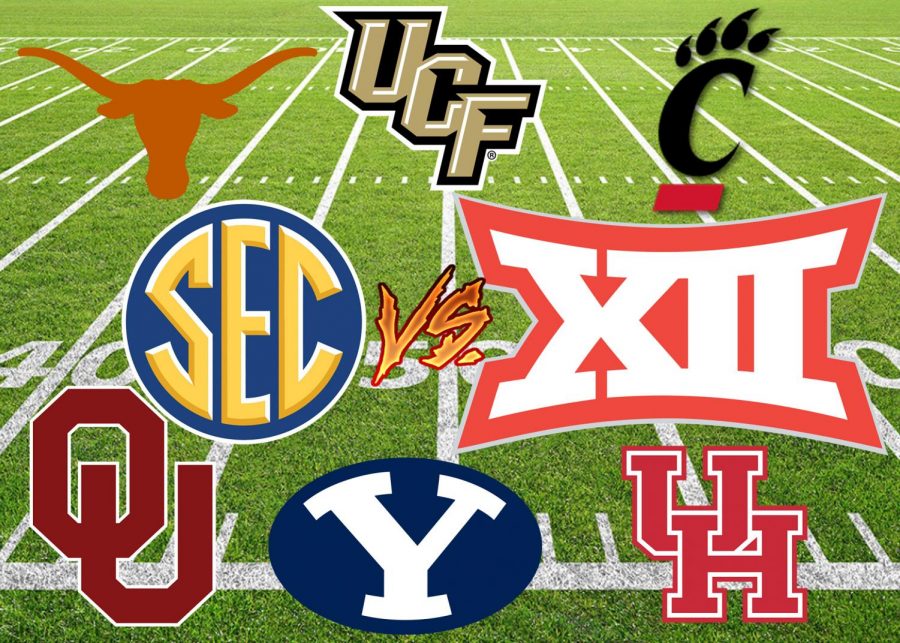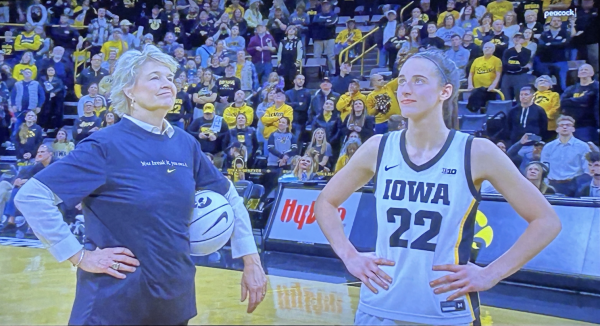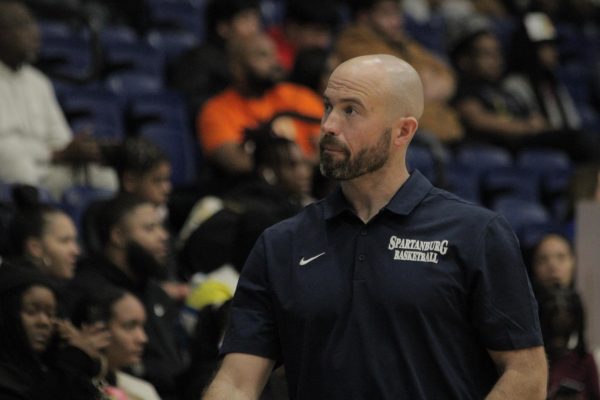College Sports Conferences get a Realignment
As college football season begins, teams and their respective conferences remain in question
Photo illustration by W. Eaton
College teams remain in limbo as conferences get realigned, creating shake-ups in the college football world.
September 22, 2021
2021 has been a year for sports. The Tokyo Olympics just wrapped up, which on its own offered spectacular feats and records. The NBA season also came to a close, with the Milwaukee Bucks winning their first title in 50 years. Not to mention the NFL Super Bowl, with Tom Brady claiming his seventh title win, this time with the Tampa Bay Buccaneers.
Before the college football season even started, there was already some groundbreaking news concerning the college conferences.
Shockwaves were sent through the college football world when the Texas Longhorns and the Oklahoma Sooners, two college football powerhouses, were rumored to be joining the Southeastern Conference (SEC).
This news was first reported when both teams skipped a conference phone call, and later was confirmed when they officially asked the SEC if they could join. The SEC unanimously accepted these two teams, and Texas and Oklahoma could now be a part of the SEC as early as 2025, according to SEC commissioner Greg Sankey.
“Today’s unanimous vote is both a testament to the SEC’s longstanding spirit of unity and mutual cooperation, as well as a recognition of the outstanding legacies of academic and athletic excellence established by the Universities of Oklahoma and Texas,” Sankey said, according to tennesseean.com.
The SEC represents the Southern football world, and already contains perennial championship-contending teams, such as the Alabama Crimson Tide, the Florida Gators and the Georgia Bulldogs. The addition of these two teams will create arguably the most power-packed and watched conference in the country.
Many fans of the SEC and college football are in favor of this change. Halle Abbott (9) is one of these fans that is excited by the move.
“The move by Texas and Oklahoma could potentially draw more attention towards both teams and create marketing for them,” Abbott said.
By most standards, this is a good move for both Texas and Oklahoma, which can bring more attention to their respective football programs. Previously, they played teams who more often than not suffered from losing seasons, such as the Kansas Jayhawks and the Kansas State Wildcats. But both the Longhorns and the Sooners will be challenged more in the SEC.
Carson Bishop (9), who is a fan of the South Carolina Gamecocks and SEC sports, believes this to be true.
“It will be easier to rank Oklahoma and Texas since in the past they played worse teams than other top-tier programs,” Bishop said.
There are some negatives to this massive conference switch. The Big 12, the conference that Texas and Oklahoma used to be a part of, will have less teams to watch than before, and viewership and following of the conference will likely drop. The good news for the Big 12 is they plan on having their own expansion, adding quality teams from smaller conferences like the Cincinnati Bearcats, the University of Central Florida Knights and the Brigham Young University Cougars.
Ultimately, major conferences like the ACC, Big 10 and Pac 12 will be negatively affected by these moves. However, these conferences have formed an alliance with each other that could prove to be beneficial in the long run.
With the addition of Texas and Oklahoma, the college football world can expect fireworks in the SEC in 2025. But don’t count out the other conferences, as they are slowly but surely building conferences with their own powerful teams.




















